Dell Precision M6700 Notebook Review: The Enterprise Split
by Dustin Sklavos on December 12, 2012 7:43 PM ESTDisplay Quality
For whatever reason, ColorEyes Display Pro just refuses to cooperate with the LG Philips IPS panel Dell uses in their Precision M6700 unless you calibrate at a Gamma of 1.8 instead of 2.2. This produces a fine image, but it visibly loses a lot of the pop, saturation, and gamut of the display's default calibrations. Note that Dell includes PremierColor software that actually allows you to switch between different color gamuts, and it's a welcome feature.
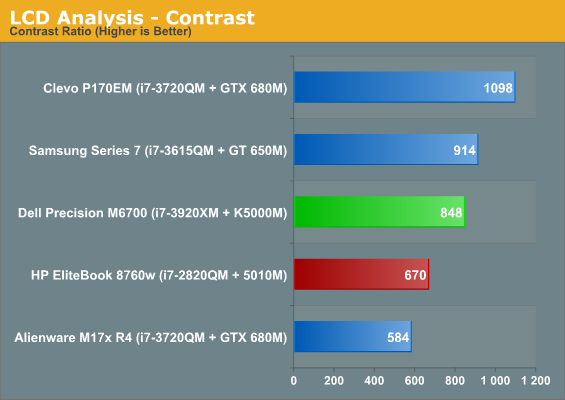
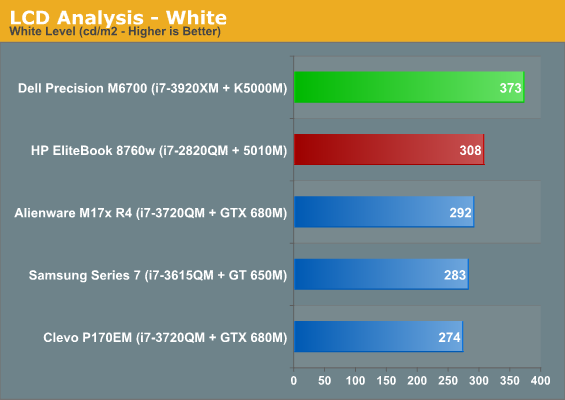

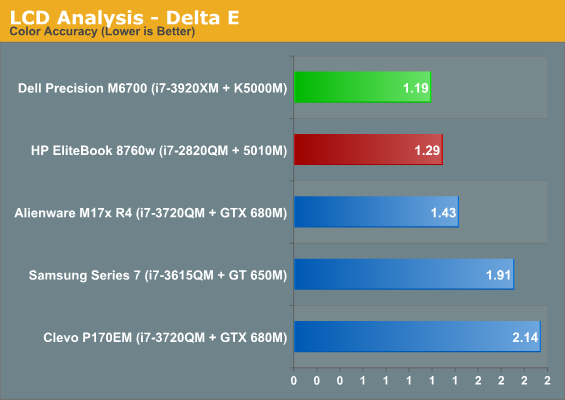

The measurements are generally solid, with the PremierColor display at least offering a solid sRGB color gamut. Unfortunately due to issues with ColorEyes Display Pro I'm unable to confirm whether or not it can truly produce the entire AdobeRGB1998 color gamut like Dell claims it can, but honestly I believe it can.
Frankly it's a beautiful display and anecdotally it's on par with the DreamColor display-equipped EliteBook I currently have in house for testing, maybe even a step up due to Dell's PremierColor software which allows you to not only choose the color gamut you want to work with, but will even detect applications and adjust accordingly.
Battery Life
Where these workstations are still lagging substantially behind their consumer counterparts is in their power management technology. NVIDIA's Optimus has been thriving for years now on consumer GPUs, but Quadro chips still don't benefit from it. AMD just got Enduro working well on their mobile GPUs, but it's not functioning on FirePro chips either. As a result, the Dell Precision M6700 is forced to employ an oversized battery to compensate.
Update: Mea culpa. While Optimus is functional on NVIDIA's mobile Quadro GPUs, the use of a 10-bit IPS panel (along with either a 120Hz panel or touchscreen) precludes it due to bandwidth limitations. As a result, the M6700's battery life is going to be substantially lower with the PremierColor display, but I would actually expect M6700s with a standard TN panel to produce running time closer to the Alienware M17x R4, which has a smaller battery but similar silicon.

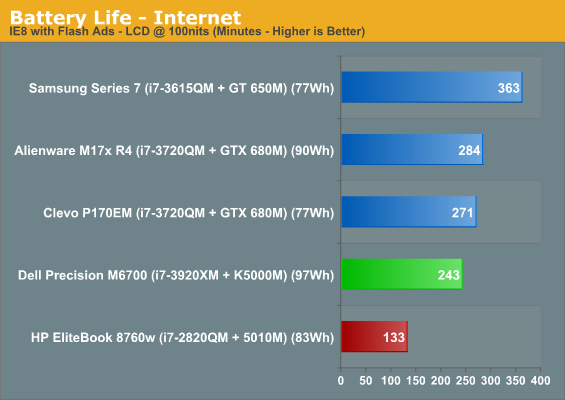
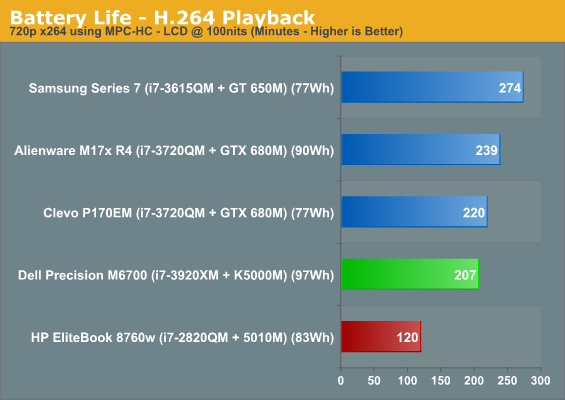
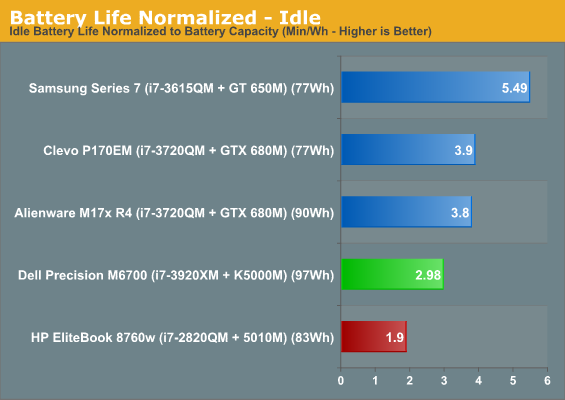
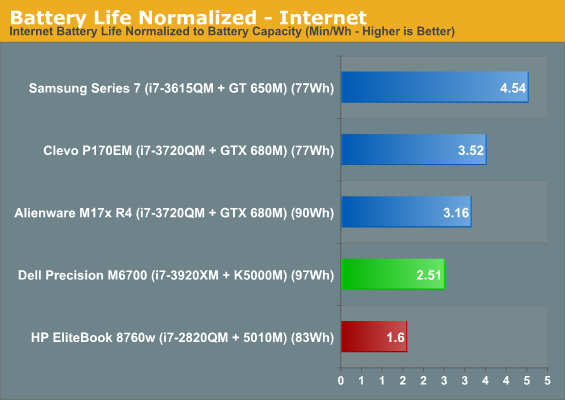
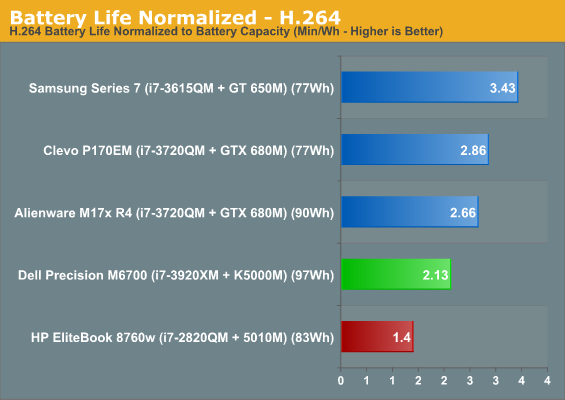
Optimus-enabled notebooks are able to get at least a little more mileage. The M6700's battery life actually isn't that bad given that it's a workstation notebook, owing at least somewhat to both Ivy Bridge's frugal power consumption and Kepler's superior idle power compared to Fermi.
Heat and Noise
Thankfully, the Dell Precision M6700's beefy cooling system keeps the notebook running both reasonably cool and quiet. Keep in mind that we're working with a combined TDP of roughly 155W on the CPU and GPU in this system when you take a look at the thermals below.

The CPU runs nice and toasty, but the M6700 is actually very effective at keeping the K5000M cool. Noise levels are very good, with the notebook basically inaudible at idle and fan noise being a low, quiet whoosh under load.


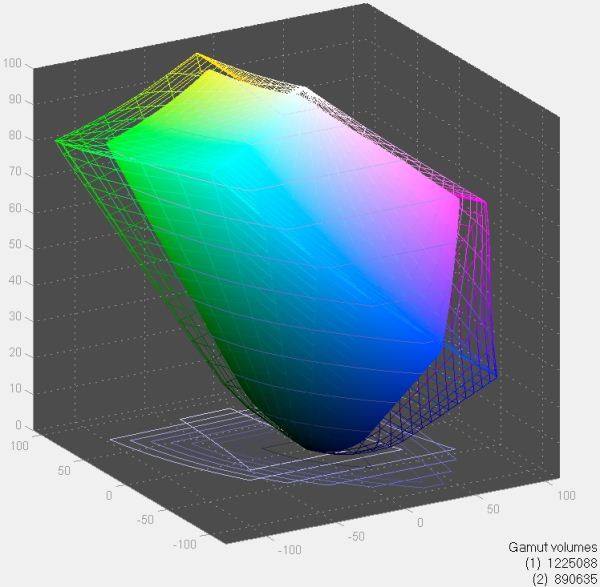








125 Comments
View All Comments
bramv101 - Thursday, December 13, 2012 - link
Architects and graphic designers?Google for CFD, FEA, Siemens NX, Catia --> these are the type of software that dell keeps in mind when designing this mobile workstation, and I would say that this type of industry is considerably bigger then the photoshop/maya users out there.
I think most scientist/engineers like myself would not consider apple for any serious work.
Macbook pro is targeted at another market that does not need this type of quadro GPU or high level CPU
ingwe - Thursday, December 13, 2012 - link
ndornquast: People who are buying this to use for work probably don't care that much about the aesthetics.bramv101: I am an astrophysicist who is currently working as an engineer and most all of my colleagues and previous colleagues use an apple for just about everything (the main exception is if they are putting simulation work on a cluster). Apples definitely have their place in the scientist/engineering world, but it definitely depends on what the workload is going to be. The CPUs in the current line definitely aren't slouches. I can understand how a lot of people can't use them because of the lack of workstation graphics though.
A5 - Thursday, December 13, 2012 - link
I'm an embedded systems engineer, and none of the software I need to do my job (besides Office I guess) is available natively on OS X. I'd actually have an easier time switching to Linux than OS X at work :-pA5 - Thursday, December 13, 2012 - link
That said, we have a couple Macbooks for people that travel a lot, but the first thing we do to them is Boot Camp Win7 and set it as the default OS. We don't do our heavy stuff on the road, so a 13-inch MBP running some of our on-site tools is a great option.Old_Fogie_Late_Bloomer - Thursday, December 13, 2012 - link
I am certainly all for form following function...or at least form being somewhat aesthetically informed by function (ThinkPads for the win)......but good god. That thing looks exactly like what you'd get if you bought a laptop-shaped Christmas ornament. It's like a parody of laptop design, but they're being serious.
CobaltFire - Thursday, December 13, 2012 - link
As an owner of an Optimus equipped Quadro 4000M packing M6600, I will say it (Optimus) works fine. What stops it from functioning is the IPS display. The bit width (8 or 10, I cannot remeber) means that the IGP cannot actually run the display.This is a known fact for those of us who put our money down for these, and affects the PremiereColor machines as well.
CobaltFire - Thursday, December 13, 2012 - link
I meant that the issue affects both PremiereColor (Dell) and DreamColor (HP) alike. This is an issue unique to the IPS panels, and why many buyers purchase the quite good standard 1080p models.ijozic - Thursday, December 13, 2012 - link
Yeah, exactly. I'm surprised that the reviewer doesn't know this. The IPS panels are 10-bit, while the Intel IGP is again 8-bit.Dell actually went the extra mile here compared to the HP - the HP just circumvented the IGP together and the Optimus is not supported even if you get the non-IPS configuration. Dell M6700 (as the M6600 before it) on the other hand has two display connectors on their mainboards, one which circumvents the IGP, one which takes the IGP output. So, if you configure your Dell with a regular screeen (supposedly, the 3D screen isn't supported by the IGP, neither), you can get the Optimus functioning and double your battery life.
I don't get the rage about the keyboard. For instance, I use arrow keys rather than numpad to get around (I presume the reviewer uses the numpad arrows) so the document keys above the numeric keypad are almost unusable as they are hard to reach. Getting the PgUp/PgDn keys finally next to the arrow keys is a godsend and I only wish they had the secondary Home/End functionality added in combination with the Fn key.
The whole review seems rather subjectively negative like it stems from the fact that the reviewer prefers the HP design and keyboard (which has awful arrow keys, personally). Yes, I prefer the HP boxy aluminum looks, too (apart from that ugly silver panel under the display) and think that M6700 is somewhat a step back from the M6400/M6500 (the two-tone inside colors and the keys remind me of the HP 8740W design), but I would still go for the M6700 as it has better cooling, QC (from what I'm reading in the owners threads) and Optimus support.
kabelmk - Thursday, December 13, 2012 - link
So, is the MacBook Pro Retina 15" 8-bit or 10-bit?kabelmk - Thursday, December 13, 2012 - link
Or is it 6-bit panel?